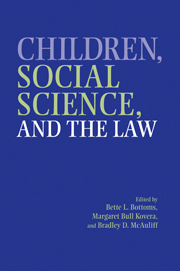Book contents
- Frontmatter
- Contents
- Acknowledgments
- Contributors
- 1 Children, Social Science, and the Law: An Introduction to the Issues
- PART I CHILDREN'S RIGHTS, THEIR CAPABILITIES, AND SOCIETY'S RESPONSIBILITIES TO CHILDREN
- PART II CHILDREN AND FAMILY CHANGE
- PART III JUVENILE AGGRESSION AND JUVENILE JUSTICE
- 9 Juvenile Transfer to Adult Court: How Can Developmental and Child Psychology Inform Policy Decision Making?
- 10 Youth Violence: Correlates, Interventions, and Legal Implications
- 11 Capacity, Competence, and the Juvenile Defendant: Implications for Research and Policy
- PART IV CHILDREN AS VICTIMS AND WITNESSES
- PART V CONCLUSIONS AND FUTURE DIRECTIONS
- Author Index
- Case Index
- Subject Index
- References
11 - Capacity, Competence, and the Juvenile Defendant: Implications for Research and Policy
Published online by Cambridge University Press: 24 July 2009
- Frontmatter
- Contents
- Acknowledgments
- Contributors
- 1 Children, Social Science, and the Law: An Introduction to the Issues
- PART I CHILDREN'S RIGHTS, THEIR CAPABILITIES, AND SOCIETY'S RESPONSIBILITIES TO CHILDREN
- PART II CHILDREN AND FAMILY CHANGE
- PART III JUVENILE AGGRESSION AND JUVENILE JUSTICE
- 9 Juvenile Transfer to Adult Court: How Can Developmental and Child Psychology Inform Policy Decision Making?
- 10 Youth Violence: Correlates, Interventions, and Legal Implications
- 11 Capacity, Competence, and the Juvenile Defendant: Implications for Research and Policy
- PART IV CHILDREN AS VICTIMS AND WITNESSES
- PART V CONCLUSIONS AND FUTURE DIRECTIONS
- Author Index
- Case Index
- Subject Index
- References
Summary
Some form of delinquent activity is a common aspect of development for a majority of youth. For many, it appears to represent a time-delimited activity of adolescence that doesn't necessarily come to the attention of a formal system of social control (Moffit, 1993). However, a significant proportion of adolescents comes into contact with the justice system as a result of this behavior. In 1994, juvenile courts saw 1.75 million delinquency cases, with approximately 980,000 cases processed formally through a petition for an adjudicatory or waiver hearing (Stahl et al., 1999). For those adolescents who do come into contact with it, the justice system can represent a significant intervention in their lives (see Salekin and Fried and Reppucci, this volume, for a discussion of factors that contribute to juvenile violence).
The notion that adolescents are immature, have less decision-making capacity, and therefore should be treated differently than adults has permeated the juvenile justice system since its inception in 1899. Historical differences between the juvenile and adult criminal justice systems have been based on a fundamental notion about adolescent development and the appropriate societal response. In the criminal system, adults are presumed to be autonomous, competent persons who are able to make their own decisions about behavior and are held accountable for their choices. Because of their ongoing cognitive and social development, however, juveniles are considered less able to make competent decisions, and therefore are held less culpable and less accountable for their actions.
- Type
- Chapter
- Information
- Children, Social Science, and the Law , pp. 270 - 298Publisher: Cambridge University PressPrint publication year: 2002
References
- 8
- Cited by



